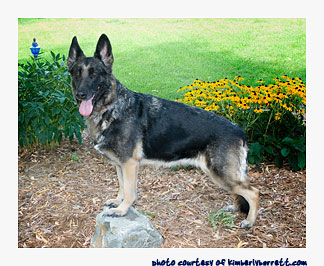A fellow dog trainer looking for a solution for a client’s dog posed this question:
"What can be done about a dog that regularly climbs over a chain link fence? Would you suggest a privacy fence or invisible fence?"
Marilyn’s Response:
I would definitely opt for in-ground pet containment (a.k.a invisible fence)… and here is my insight and opinion, as I have a fair amount of experience with in-ground pet containment systems.
Likely even a premium quality in-ground pet containment system would be less expensive than a privacy fence. Not all pet containment systems are created equally. The products are not the same and even within a product, the training is not the same (assuming training is done by a professional, there is a better chance that it will be consistent, but still the dogs we work with are individuals and the pet owners are also a factor). That said, there are other variables that come into play even after installation and training is complete… Did the owner follow final training instructions? Is the collar fit properly every time the dog is in the yard? Is the battery strength good? Is the fence working (or is there a line break or power failure)?
Not all pet containment systems are created equally. The products are not the same and even within a product, the training is not the same (assuming training is done by a professional, there is a better chance that it will be consistent, but still the dogs we work with are individuals and the pet owners are also a factor). That said, there are other variables that come into play even after installation and training is complete… Did the owner follow final training instructions? Is the collar fit properly every time the dog is in the yard? Is the battery strength good? Is the fence working (or is there a line break or power failure)?Nothing, including supervision and a leash is 100%. I've observed dogs escape their owner or their leash by pulling the leash out of hand or backing out of a too-loose collar.
In-ground pet containment systems do not encourage fence fighting, charging or running any more than a physical fence does. Pet owners need to be responsible for their own inaction when these behaviors arise. A professional trainer should be contacted to help the pet owner understand and alleviate any inappropriate behaviors.
In-ground pet containment systems do not keep critters, people or other dogs out of your yard. So in that respect they are less of an incoming deterrent than a physical fence and clearly they can be more frightening for passersby if a large dog comes charging, stopping short of the fence line. These are all things an owner should be made aware of.
Even a physical fence will not deter intact dogs from mating or leaving home for a ‘date’ when females are in heat. Pet owners of intact animals need to take responsibility for their animal’s mating behavior and offspring.
That said, in-ground pet containments systems are helpful to people living in town homes or associations that do not allow physical fences, they are great for people who are physically impaired and cannot get their dogs out for walks multiple times a day, and let's face it - winter in MN is not kind for those early morning potty breaks. In-ground pet containment allows the homeowner to ‘fence’ a relatively large area (in some cases many acres) or a yard with unusual topography less expensively than physical fence. Yard maintenance is easier with in-ground pet containment, because you don’t need to mow or weed-whip around physical fence and in some neighborhoods physical fences are not an option.
These systems are a convenience and a tool, to be used properly like any other. Keep in mind that the purpose of pet containment is to keep the dog home; it's not a magic bullet for remedying all issues… hopefully, that's where good trainers come in.
I have a few of my own stories of picking up dogs that `somehow' escaped their `electric' fences. When returning them to the owners I always help them figure out why their dog left and encourage them to remedy the problem. In some cases the owner is glad of my knowledge and appreciative of my time and care. In two cases, I was flabbergasted that the people had so little regard for my concern and, of course, dragged their dog off for a reprimand. It's disheartening when you care more for another person's dog's well being then they appear to. Education and compassion is the only real resources I have available in such situations, I hope I can be effective, even if in that moment I feel my intent has failed.
For as many pet-containment fences that are installed, I'm sure there are an incredibly low percentage of breeches, but yes they do happen. I don't know any way to get accurate statistics on this, who would report the breech? But consider how many yards you are aware of that have dogs safely contained that do not breech? It's only the ones we pick up that we remember as the failure to the system.
Having a pet containment system in conjunction with a physical fence is an excellent option. Even in a small yard, for a jumper, the wire can be installed on the top rail of the fence and the field width can be set to an effective level to not interfere with the dog's range yet effectively deter a climbing escape. Likewise a digger-dog is easily deterred with the wire installed just outside the physical fence. For fence fighters and charging dogs (even without a physical fence) the wire can be easily moved in from the corner or sidewalk or the wiring can be configured to contain the dog in a smaller area. People do not have to have their entire yard fenced, they can have the configuration set to keep the dog in the back yard only or have the front an backyard separated, gardens can be quartered off, special potty areas can be designated, configurations can be very
creative.
In full-disclosure, I have been training for the Invisible Fence brand for about 5 years and have experience with several other systems. Of course as a trainer, I have to say great training makes
all the difference, but truthfully good product and knowledgeable tech/installers, as well as informed and informing sales people are important, too. But the truth is, even with all of that performed perfectly; there are still the variable of individual dogs, owners, environment and situations. And again, these are variables that are issues with every training, for every behavior, using every tool.
Just an FYI that people may not be aware…Invisible Fence brand (at least the Minnetonka office I know for sure) guarantees pet containment if the owner purchases 5 professional trainings. (Some owners even with Invisible Fence brand installations opt to train their dog themselves, which I think is a mistake, I even hired a professional Invisible Fence brand trainer to train my own dogs. There is benefit even to a seasoned trainer to having an Invisible Fence trainer knowledgeable about the product and unknown to the canine trainee do the work.)
Additionally, if you find an escapee dog with an Invisible Fence brand collar on them, you want to take the collar off them where you find them, so as to alleviate any further correction from other
systems in the neighborhood on the same frequency (although, usually the battery is dead – that’s how they breeched the fence in the first place - and this is probably not an issue). If the dog does not have a regular collar with their identification tags (which owners are encourage to keep both collars on when the dog is in the yard), you can contact your local Invisible Fence office. There is a serial number on the receiver that is tracked by the Invisible Fence office (if the collar was purchased from that office) and the dog can be returned.

